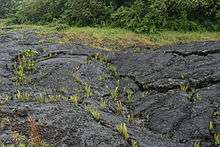Pioneer species

Pioneer species are hardy species which are the first to colonize previously biodiverse steady-state ecosystems.[1] Some lichens grow on rocks without soil, so may be among the first of life forms, and break down the rocks into soil for plants.[2] Since some uncolonized land may have thin, poor quality soils with few nutrients, pioneer species are often hardy plants with adaptations such as long roots, root nodes containing nitrogen-fixing bacteria, and leaves that employ transpiration. Note that they are often photosynthetic plants, as no other source of energy (such as other species) except light energy is often available in the early stages of succession, thus making it less likely for a pioneer species to be non-photosynthetic. The plants that are often pioneer species also tend to be wind-pollinated rather than insect-pollinated, as insects are unlikely to be present in the usually barren conditions in which pioneer species grow; however, pioneer species tend to reproduce asexually altogether, as the extreme or barren conditions present make it more favourable to reproduce asexually in order to increase reproductive success rather than invest energy into sexual reproduction. Pioneer species will die creating plant litter, and break down as "leaf mold" after some time, making new soil for secondary succession (see below), and nutrients for small fish and aquatic plants in adjacent bodies of water.[3]

Examples of the plants and organism that colonize such areas are pioneer species:
- Barren sand - lyme grass (Leymus arenarius), sea couch grass (Agropyron pungens), Marram grass (Ammophila breviligulata)
- Salt water - green algae, marine eel grass (Zostera spp.), pickleweed (Salicornia virginica), and cordgrass (hybrid Spartina × townsendii) and (Spartina anglica).
- Clear water - algae, mosses, freshwater eel grass (Vallisneria americana).
- Solidified lava flows - in Hawaii: swordfern (Polystichum munitum), ‘ōhi‘a lehua (Metrosideros polymorpha), ‘ohelo (Vaccinium reticulatum) and ‘āma‘u (Sadleria cyatheoides);[4] on Surtsey: lichen (Stereocaulon vesuvianum and Placopsis gelida) and moss (Racomitrium ericoides);[5] green algae
- Disturbed areas such as construction sites, road cuttings and verges, cultivated lands - Buddleia davidii, Nettles, Tagetes minuta, Bidens pilosa, Argemone mexicana
- Bare clay - Orchids
- Mountains - Lichens
Pioneer fauna
Pioneering fauna will colonize an area only after flora and fungi have inhabited the area. Soil fauna, ranging from microscopic protists to larger invertebrates, have a role in soil formation and nutrient cycling. Bacteria and fungi are the most important groups in the breakdown of organic detritus left by primary producing plants such as skeletal soil, moss and algae. Soil invertebrates enhance fungal activity by breaking down detritus. As soil develops, earthworms and ants alter soil characteristics. Worm burrows aerate soil and ant hills alter sediment particle size dispersal, altering soil character profoundly.
Though vertebrates in general would not be considered pioneer species, there are exceptions. Natterjack toads are specialists in open, sparsely vegetated habitats which may be at an early seral stage.[6] Wide-ranging generalists visit early succession stage habitats, but are not obligate species of those habitats because they use a mosaic of different habitats.
Vertebrates can effect early seral stages. Herbivores may alter plant growth. Fossorial mammals could alter soil and plant community development. In a profound example, a seabird colony transfers considerable nitrogen into infertile soils, thereby altering plant growth. A keystone species may facilitate the introduction of pioneer species by creating new niches. For example, beavers may flood an area, allowing new species to immigrate.[7]
Secondary succession and pioneer species
Pioneer species can also be found in secondary succession, such as an established ecosystem being reduced by an event such as: a forest fire, deforestation, or clearing; quickly colonizing open spaces which previously supported vegetation.[8]
Common examples of the plants in such areas include:
- Raspberry - Rubus spp.
- Heaths - Ericaceae spp.
- Graminoids, forbs, and wildflowers - native, introduced, and invasive species: such as fire dependent seed, cone, and resprouter chaparral genera.[9]
See also
References
| Wikimedia Commons has media related to Pioneer plants. |
- ↑ Duram, Leslie A. (2010). Encyclopedia of Organic, Sustainable, and Local Food. ABC-CLIO. p. 48. ISBN 9780313359637.
- ↑ LICHEN BIOLOGY AND THE ENVIRONMENT, LICHENS OF NORTH AMERICA, Sylvia and Stephen Sharnoff,
- ↑ Walker, Lawrence R.; Moral, Roger del (2003-02-13). Primary Succession and Ecosystem Rehabilitation. Cambridge University Press. ISBN 9780521529549.
- ↑ Amazing Lava Products and Forms, U.S. National Park Service. Retrieved 2015-06-16.
- ↑ http://www.surtsey.is/pp_ens/biola_3.htm
- ↑ Faucher, Leslie; Hénocq, Laura; Vanappelghem, Cédric; Rondel, Stéphanie; Quevillart, Robin; Gallina, Sophie; Godé, Cécile; Jaquiéry, Julie; Arnaud, Jean-François (2017-09-01). "When new human-modified habitats favour the expansion of an amphibian pioneer species: Evolutionary history of the natterjack toad (Bufo calamita) in a coal basin". Molecular Ecology. 26 (17): 4434–4451. doi:10.1111/mec.14229. ISSN 1365-294X.
- ↑ Wallwork, John Anthony (1970). Ecology of Soil Animals. McGraw-Hill. ISBN 0070941254.
- ↑ E.,, Ricklefs, Robert. Ecology : the economy of nature. Relyea, Rick,, Richter, Christoph F.,, Revision of: Ricklefs, Robert E. (Seventh edition, Canadian ed.). New York, NY. ISBN 9781464154249. OCLC 961903099.
- ↑ Knox, Kirsten J. E.; Morrison, David A. (2005-06-01). "Effects of inter-fire intervals on the reproductive output of resprouters and obligate seeders in the Proteaceae". Austral Ecology. 30 (4): 407–413. doi:10.1111/j.1442-9993.2005.01482.x. ISSN 1442-9993.